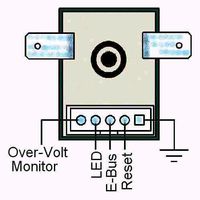|
An
historic method of handling an over-voltage problem from a failed voltage
regulator or alternator was to electronically drop a short circuit across the
line with a big SCR. This technique was called “crowbar” since it
was like short-circuiting bare wires with a crowbar. Dude...!
The old crowbar method was very reliable since it forced a fuse or breaker to
blow, disconnecting the circuit. But then again it blew a fuse or
breaker…and some think this is inelegant and introduces its own
problems, such as Godzilla-like current surges and induced load dumps, even
if it is kinda…well, Macho…!
OV protection is critical since an errant high voltage will not necessarily
blow any current-activated circuit protection devices, while it can do
extensive damage to your electronics.
But we make a tiny domino-size module that monitors the voltage on the main
bus (or anyplace), lights a panel-mounted warning LED when the monitored
voltage rises above 16.2V for more than 200 mS and politely opens
(disconnects) the alternator field circuit or B+ contactor (or whatever). A
user-supplied over-ride switch (wired to E-BUS+ or battery bus) will
reconnect the circuit, and if held in will even keep the circuit on. A
"Mom-Off-On" switch might be nice, too—if you really want
complete control!
It can be mounted by double-sided tape or bonded to a small attachment plate,
or bolted as desired. A resistor or potentiometer in series with the external
LED for dimming can be used but is not required.
|
Basic
Specifications: Dimensions: 1.03” X 1.50” X 0.30” (26 X 38
X 8 mm).
Weight: about 1/2 ounce (15g)
Connectors: 0.250” male Faston tabs and 5-pin Molex locking connector
(mating plug supplied).
Over-volt warning and trip level 16.20 +/- 0.15 V
Maximum Voltage Input=18 VDC nominal
Maximum Allowable Continuous Current = 5A

US$52
Free Shipping to Can-US-Mexico. Foreign USPS at cost.
EXPERIMENTAL AIRCRAFT USE ONLY
|